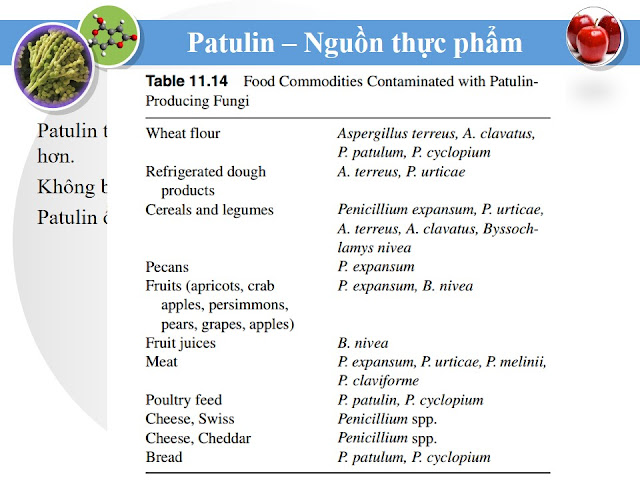Tài liệu tham khảo:
[1] J.W.
DeVries, et al., Mycotoxins and Food Safety: Springer US, 2002.
[2] R. R. M.
Paterson and N. Lima, Molecular Biology of Food and Water Borne Mycotoxigenic
and Mycotic Fungi: CRC Press, 2015.
[3] Nguyễn Phùng
Tiến, Vi Sinh Vật Thực Phẩm vol. 2: NXB Y Học, 2007.
[4] C.A. Batt
and R.K. Robinson, Encyclopedia of Food Microbiology: Elsevier Science, 1999.
[5] Lê Ngọc Tú,
Độc tố học và an toàn thực phẩm NXB khoa học và kỹ thuật, 2006.
[6] T. Koszegi
and M. Poor, "Ochratoxin A: Molecular Interactions, Mechanisms of Toxicity
and Prevention at the Molecular Level," Toxins (Basel), vol. 8, p. 111,
Apr 15 2016.
[7] André El
Khoury and Ali Atoui, "Ochratoxin A: General Overview and Actual Molecular
Status," Toxins, vol. 2, 2010.
[8] M. J. Sweeney
and A. D. Dobson, "Mycotoxin production by Aspergillus, Fusarium and
Penicillium species," Int J Food Microbiol, vol. 43, pp. 141-58, Sep 08
1998.
[9] Luís
Abrunhosa, et al., "Biodegradation of Ochratoxin A for Food and Feed
Decontamination," Toxins, vol. 2, pp. 1078-1099, 2010.
[10] A. Gallo, et
al., "New insight into the ochratoxin A biosynthetic pathway through
deletion of a nonribosomal peptide synthetase gene in Aspergillus
carbonarius," Appl Environ Microbiol, vol. 78, pp. 8208-18, Dec 2012.
[11] Frantisek
Malir, et al., "Ochratoxin A: 50 Years of Research," Toxins, vol. 8,
2016.
[12] A.
Pfohl-Leszkowicz and R. A. Manderville, "Ochratoxin A: An overview on
toxicity and carcinogenicity in animals and humans," Mol Nutr Food Res,
vol. 51, pp. 61-99, Jan 2007.
[13] S. S.
Deshpande, Handbook of Food Toxicology: Taylor & Francis, 2002.
[14] Olivier Puel,
et al., "Biosynthesis and Toxicological Effects of Patulin," Toxins,
vol. 2, 2010.
[15] Y; Cox He,
RJ, "The molecular steps of citrinin biosynthesis in fungi," Chemical
Science, vol. 7, pp. 2119–2127, 2016.
[16] H; Smith
Raistrick, G, "Anti-bacterial substances from moulds. Part I. Citrinin, a
metabolic product of Penicillium citrinum Thom," Chemistry and Industry,
vol. 60, pp. 828–830, 1941.
[17] J; Peraica
Flais, M "Toxicological properties of citrinin," Archies of
industrial hygiene and toxicology, vol. 60, pp. 457–464, 2009.
[18] R; Luz
Poupke, Z; Destro, R, "Carbon-13 NMR of citrinin in the solid state and
solutions," Journal Physical Chemistry A, vol. 101, pp. 5097–5102, 1997.
[19] European Food
Safety Authority, "Scientific Opinion on the risks for public and animal
health related to the presence of citrinin in food and feed.," EFSA
Journal, vol. 10, 2012.
[20] AM; DeEds
Ambrose, F, "Some toxicological and pharmacological properties of
citrinin," The Journal of Pharmacology and Experimental Therapeutics, vol.
88, pp. 173-186, 1946.
[21] C; Carlton
Hanika, WW; Tuite, J, "Citrinin mycotoxicosis in the rabbit," Food
and Chemical Toxicology, vol. 21, pp. 487-493, 1983.
[22] NA; Carlton
Mehdi, WW; Tuite, J, "Acute toxicity of citrinin in turkeys and ducklings,"
Avian Pathology, vol. 12, pp. 221-233, 1983.
[23] C. Wittmann,
et al., Industrial Biotechnology: Microorganisms: Wiley, 2016.
[24] J. F. Martín,
et al., Biosynthesis and Molecular Genetics of Fungal Secondary Metabolites:
Springer New York, 2014.
[25] M. K. Cowan,
Microbiology Fundamentals: A Clinical Approach: McGraw-Hill Education, 2012.
[26] P.R. Murray,
et al., Medical Microbiology: Elsevier/Saunders, 2013.
[27] Elissa Lane
Miller, "THE PENICILLINS: A REVIEW AND UPDATE," The Journal of
Midwifery & Women’s Health, vol. 47, pp. 426-434,
2002.
[28] M. A.
Penalva, et al., "The optimization of penicillin biosynthesis in
fungi," Trends Biotechnol, vol. 16, pp. 483-9, Nov 1998.
[29] Nguyễn Văn
Cách, Công nghệ lên men các chất kháng sinh: Nhà xuất bản Khoa học Kỹ thuật,
2005.




















































































0 comments:
Post a Comment